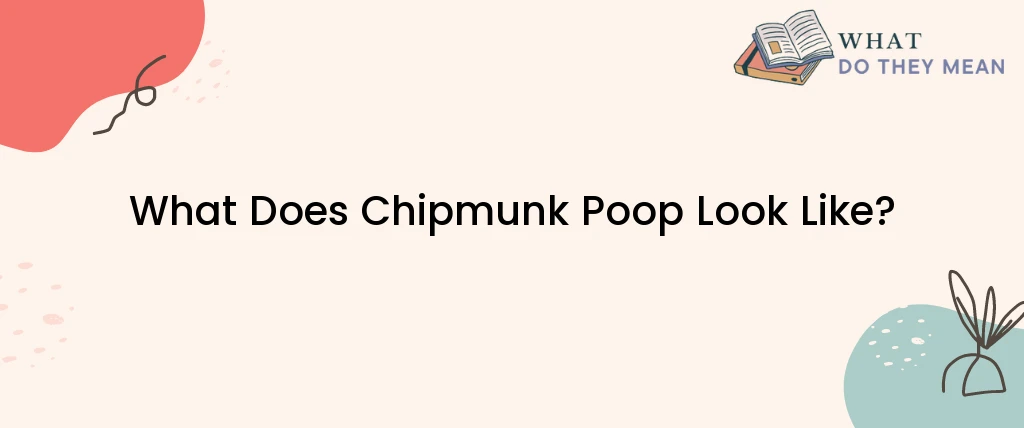Chipmunk poop is small, usually no more than 1/4 inch in length, and about as wide as a pencil lead. It is generally oval-shaped with tapered ends and can be light brown, dark brown, or black in color. The texture of chipmunk droppings is firm and dry, similar to that of small grains of rice. They are often found in small piles or scattered along trails or in areas where chipmunks frequent.
Chipmunks are small, cute, and furry creatures that are commonly found in North America. They are members of the squirrel family and are known for their energetic behavior and playful nature. However, like all animals, they do leave their mark on the environment, and that includes their droppings. In this article, we will take a closer look at what chipmunk poop looks like and what it can tell us about these interesting little critters.
Appearance
Chipmunk poop is small, usually no more than 1/4 inch in length, and about as wide as a pencil lead. It is generally oval-shaped with tapered ends and can be light brown, dark brown, or black in color. The texture of chipmunk droppings is firm and dry, similar to that of small grains of rice. In some cases, the droppings may appear slightly curved, which is due to the shape of the chipmunk’s intestines. Overall, chipmunk poop is relatively easy to identify, even for those who are not familiar with animal droppings.
Where to Find Chipmunk Poop
If you are interested in finding chipmunk poop, the best place to look is in areas where chipmunks are known to live. This can include wooded areas, parks, and suburban neighborhoods where there is plenty of cover and food available. Chipmunks are also known for creating burrows and tunnels, which can be found in the soil or under rocks and logs. You may also be able to find chipmunk poop along trails and in areas where they frequently run or climb. If you are not sure whether you have found chipmunk poop, you can compare it to pictures of chipmunk droppings online or consult with a local wildlife expert.
What Chipmunk Poop Can Tell Us
While chipmunk poop may not be the most pleasant thing to think about, it can actually tell us a lot about these animals. For example, the size and color of the droppings can give us clues about what the chipmunk has been eating. Chipmunks are known for having a varied diet, which can include nuts, seeds, fruit, insects, and even small animals like snails and worms. Depending on what they have been eating, their poop may appear darker or lighter in color or may contain bits of food that are identifiable.
In addition to their diet, chipmunk poop can also tell us about their behavior. For example, the presence of a large number of droppings in one area may indicate that a chipmunk has been living or feeding there. Similarly, the shape and texture of the droppings can give us information about the health of the animal. Healthy chipmunks will typically produce firm, well-formed droppings, while sick or stressed animals may produce droppings that are loose or runny.
You may also like: What Does It Mean When A Bird Poops On You?
Health Risks
While chipmunk poop may not be harmful in and of itself, it is important to take precautions when handling animal droppings. This is because animal feces can carry a variety of diseases and parasites, including the hantavirus, salmonella, and giardia. To reduce the risk of disease transmission, it is recommended that you wear gloves and avoid touching the droppings with your bare hands. You should also wash your hands thoroughly after handling the droppings and avoid touching your face or mouth.
In addition to the health risks associated with chipmunk poop, it is also important to consider the impact that these animals can have on your property. While they may be cute and fun to watch, chipmunks are known for digging holes and burrows that can cause damage to lawns and gardens. They can also chew through wiring and cause damage to buildings and other structures. To prevent damage to your property, it may be necessary to take steps to deter chipmunks from your yard, such as removing sources of food and shelter or installing fencing or barriers to keep them out.
Conclusion
Chipmunk poop may not be the most pleasant topic, but it can tell us a lot about these interesting little animals. By understanding what their droppings look like and what they can tell us, we can gain a deeper appreciation for these creatures and their place in the ecosystem. While it is important to take precautions when handling animal droppings, we can also take steps to prevent damage to our property and maintain a healthy and harmonious relationship with the natural world around us.

As a researcher, I am curious and driven by the pursuit of knowledge. I approach my work with a critical eye, carefully evaluating sources and methods to ensure that my findings are accurate and reliable. Whether delving into scientific studies, historical records, or cutting-edge technologies, I am always seeking to expand my understanding and make new discoveries. I am dedicated to uncovering new insights and finding solutions to complex problems, and am driven by a passion for uncovering the truth.



